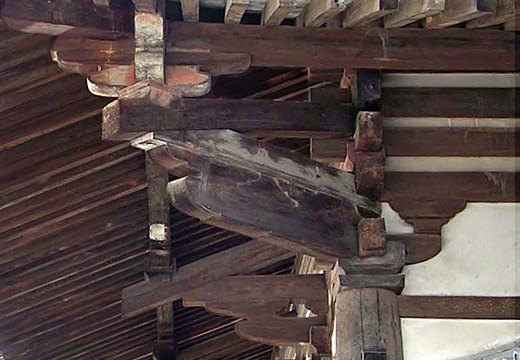|
||
 |
||

Houryuuji Chuumon 法隆寺中門 (Nara)
(C)2001 Japanese Architecture and Art Net Users System. No reproduction or republication without written permission.
掲載のテキスト・写真・イラストなど、全てのコンテンツの無断複製・転載を禁じます。
|
||||||
| kumotokyou 雲斗きょう | ||||||
| KEY WORD : architecture / general terms | ||||||
| Also called kumogata tokyou 雲形斗きょう or kumogata kumimono 雲形組物. Lit. cloud pattern bracket complex. A bearing block *masu 斗 and bracket arm *hijiki 肘木 shaped into an undulating pattern that is thought to resemble clouds. Hence, the bearing blocks are called *kumoto 雲斗 and the bracket arms are *kumohijiki 雲肘木. Their use is limited to *Kondou 金堂, *Gojuu-no-tou 五重塔 and *Chuumon 中門 at Houryuuji 法隆寺 (7c-8c), Hokkiji 法起寺 *Sanjuu-no-tou 三重塔 (706), Hourinji 法輪寺 Sanjuu-no-tou 法輪寺三重塔 (late 7c, burned 1944, reconstructed 1978) and the *Tamamushi no zushi 玉虫厨子 (mid- 7c). All of these structures are located close together in Nara. These bracket complexes are thought to be a unique characteristic of the Asuka period master builders of these temples. There is no concrete evidence that this bracket complex was derived from a continental style. At Houryuuji the large bearing blocks *daito 大斗 were positioned on circular plates *sarato 皿斗 and the bracket arms and small bearing blocks *makito 巻斗 with their cloud-patterned forms are tightly joined so as to appear as if carved from one piece of timber. Thus a harmonious relationship between the curves of the bearing blocks and bracket arms was created. The flow of the curves differs slightly from structure to structure. Those at Houryuuji Kondou are more elaborate with the sides of the bracket arms being decorated with wave-like designs. Buildings with kumotokyou have only one bracket complex projecting directly from the corner, in contrast to conventional bracket systems whereby there are three complexes that project at the corner and one on either side that extends at a right angle to the facade. | ||||||
 Houryuuji Chuumon 法隆寺中門 (Nara)
|
||||||
| REFERENCES: | ||||||
| EXTERNAL LINKS: | ||||||
| NOTES: | ||||||
(C)2001 Japanese Architecture and Art Net Users System. No reproduction or republication without written permission. 掲載のテキスト・写真・イラストなど、全てのコンテンツの無断複製・転載を禁じます。 |
||||||